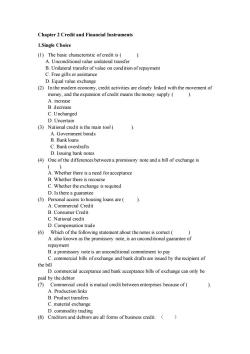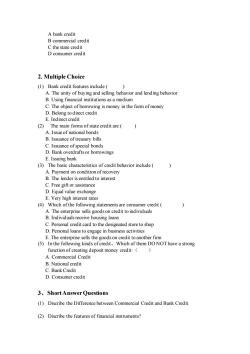同济大学:《货币金融学》课程教学资源(试卷习题)Chapter 2 Credit and Financial Instruments

Chapter 2 Credit and Financial Instruments 1.Single Choice (1)The basic characteristic of credit is () A.Unconditional value unilateral transfer B.Unilateral transfer of value on cond ition of repayment C.Free gifts or assistance D.Equal value exchange (2)In the modern economy,credit activities are closely linked with the movement of money,and the expansion of credit means the money supply () A.increase B.decrease C.Unchanged D.Uncertain (3)National credit is the main tool A.Government bonds B.Bank loans C.Bank overdrafts D.Issuing bank notes (4)One of the differences between a promissory note and a bill of exchange is A.Whether there is a need for acceptance B.Whether there is recourse C.Whether the exchange is required D.Is there a guarantee (5)Personal access to housing loans are () A.Commercial Credit B.Consumer Credit C.National credit D.Compensation trade (6)Which of the following statement about the notes is correct ( A.also known as the promissory note,is an uncond itional guarantee of repayment B.a promissory note is an uncond itional commitment to pay C.commercial bills of exchange and bank drafts are issued by the recipient of the bill D.commercial acceptance and bank acceptance bills of exchange can only be paid by the debtor (7)Commercial credit is mutual credit between enterprises because of A.Production links B.Product transfers C.material exchange D.commodity trading (8)Creditors and debtors are all forms of business credit.(
Chapter 2 Credit and Financial Instruments 1.Single Choice (1) The basic characteristic of credit is ( ). A. Unconditional value unilateral transfer B. Unilateral transfer of value on condition of repayment C. Free gifts or assistance D. Equal value exchange (2) In the modern economy, credit activities are closely linked with the movement of money, and the expansion of credit means the money supply ( ). A. increase B. decrease C. Unchanged D. Uncertain (3) National credit is the main tool ( ). A. Government bonds B. Bank loans C. Bank overdrafts D. Issuing bank notes (4) One of the differences between a promissory note and a bill of exchange is ( ). A. Whether there is a need for acceptance B. Whether there is recourse C. Whether the exchange is required D. Is there a guarantee (5) Personal access to housing loans are ( ). A. Commercial Credit B. Consumer Credit C. National credit D. Compensation trade (6) Which of the following statement about the notes is correct ( ) A. also known as the promissory note, is an unconditional guarantee of repayment B. a promissory note is an unconditional commitment to pay C. commercial bills of exchange and bank drafts are issued by the recipient of the bill D. commercial acceptance and bank acceptance bills of exchange can only be paid by the debtor (7) Commercial credit is mutual credit between enterprises because of ( ). A. Production links B. Product transfers C. material exchange D. commodity trading (8) Creditors and debtors are all forms of business credit. ( )

A bank credit B commercial credit C the state credit D consumer credit 2.Multiple Choice (1)Bank credit features include( A.The unity of buying and selling behavior and lending behavior B.Using financial institutions as a medium C.The object of borrowing is money in the form of money D.Belong to direct credit E.Indirect credit (2)The main forms of state credit are A.Issue of national bonds B.Issuance of treasury bills C.Issuance of special bonds D.Bank overdrafts or borrowings E.Issuing bank (3)The basic characteristics of credit behavior include( A.Payment on condition of recovery B.The lender is entitled to interest C.Free gift or assistance D.Equal value exchange E.Very high interest rates (4)Which of the following statements are consumer credit A.The enterprise sells goods on credit to individuals B.Individuals receive housing loans C.Personal credit card to the designated store to shop D.Personal loans to engage in business activities E.The enterprise sells the goods on credit to another firm (5)In the following kinds of credit,Which of them DO NOT have a strong function of creating deposit money credit:() A.Commercial Credit B.National credit C.Bank Credit D.Consumer credit 3,Short Answer Questions (1)Discribe the Difference between Commercial Credit and Bank Credit. (2)Discribe the features of financial instruments?
A bank credit B commercial credit C the state credit D consumer credit 2. Multiple Choice (1) Bank credit features include ( ) A. The unity of buying and selling behavior and lending behavior B. Using financial institutions as a medium C. The object of borrowing is money in the form of money D. Belong to direct credit E. Indirect credit (2) The main forms of state credit are ( ) A. Issue of national bonds B. Issuance of treasury bills C. Issuance of special bonds D. Bank overdrafts or borrowings E. Issuing bank (3) The basic characteristics of credit behavior include ( ) A. Payment on condition of recovery B. The lender is entitled to interest C. Free gift or assistance D. Equal value exchange E. Very high interest rates (4) Which of the following statements are consumer credit ( ) A. The enterprise sells goods on credit to individuals B. Individuals receive housing loans C. Personal credit card to the designated store to shop D. Personal loans to engage in business activities E. The enterprise sells the goods on credit to another firm (5) In the following kinds of credit,Which of them DO NOT have a strong function of creating deposit money credit:( ) A. Commercial Credit B. National credit C. Bank Credit D. Consumer credit 3、Short Answer Questions (1) Discribe the Difference between Commercial Credit and Bank Credit. (2) Discribe the features of financial instruments?
按次数下载不扣除下载券;
注册用户24小时内重复下载只扣除一次;
顺序:VIP每日次数-->可用次数-->下载券;
- 同济大学:《货币金融学》课程教学资源(试卷习题)Chapter 1 Money and Monetary System.docx
- 同济大学:《货币金融学》课程教学资源(大纲教案)教学大纲 The Economics of Money and Banking.pdf
- 吉林大学:《财政学》课程教学资源(试卷习题)远程教育考试样卷(无答案).doc
- 吉林大学:《经济法》课程电子教案(PPT教学课件,共十三章,授课对象:远程教育,授课教师:孙凤英).ppt
- 《财务管理》课程教学资源(专项报告)南宁市宾阳县生猪现代农业产业园实施方案(简版).pdf
- 《财务管理》课程教学资源(专项报告)存栏1120头商品猪养殖小区可行性研究报告(简版).pdf
- 《财务管理》课程教学资源(专项报告)存栏2000头祖代原种猪场可行性研究报告(简版).pdf
- 《财务管理》课程教学资源(专项报告)存栏3000头曾祖代原种猪场环保生态养殖综合开发项目可研报告(简版).pdf
- 《财务管理》课程教学资源(专项报告)存栏5000头基础母猪现代化生猪养殖场可行性研究报告(简版).pdf
- 《财务管理》课程教学资源(专项报告)山西灵空山国家级自然保护区2016年林业国家级自然保护区补助资金建设项目可行性研究报告(简版).pdf
- 《财务管理》课程教学资源(专项报告)森林康养度假建设项目可行性研究报告(简版).pdf
- 山西农业大学:《财务管理》课程教学资源(试卷习题)财务管理期末考试模拟题三及答案.pdf
- 山西农业大学:《财务管理》课程教学资源(试卷习题)财务管理期末考试模拟题二及答案.pdf
- 山西农业大学:《财务管理》课程教学资源(试卷习题)财务管理期末考试模拟题一及答案.pdf
- 山西农业大学:《财务管理》课程教学资源(试卷习题)第八章 利润分配管理(含答案).pdf
- 山西农业大学:《财务管理》课程教学资源(试卷习题)第七章 营运资金管理(含答案).pdf
- 山西农业大学:《财务管理》课程教学资源(试卷习题)第五章 固定资产投资(含答案).pdf
- 山西农业大学:《财务管理》课程教学资源(试卷习题)第四章 筹资(含答案).pdf
- 山西农业大学:《财务管理》课程教学资源(试卷习题)第九章 财务报表分析(含答案).pdf
- 山西农业大学:《财务管理》课程教学资源(试卷习题)第二章 资金时间价值(含答案).pdf
- 同济大学:《货币金融学》课程教学资源(试卷习题)Chapter 3 Interest and Interest Rate.docx
- 同济大学:《货币金融学》课程教学资源(试卷习题)Chapter 4 The Economics of Financial Intermediary.docx
- 同济大学:《货币金融学》课程教学资源(试卷习题)Chapter 5 Commercial Banks.docx
- 同济大学:《货币金融学》课程教学资源(试卷习题)Chapter 6 Central Banks.docx
- 同济大学:《货币金融学》课程教学资源(试卷习题)Chapter 7 Financial Markets.docx
- 同济大学:《货币金融学》课程教学资源(试卷习题)Chapter 8 Money Supply and Money Demand.docx
- 同济大学:《货币金融学》课程教学资源(试卷习题)Chapter 9 Money and Inflation.docx
- 同济大学:《货币金融学》课程教学资源(试卷习题)Answers for Test Sample(参考答案)Chapter 1-10.docx
- 同济大学:《货币金融学》课程电子教案(课件讲稿)Chapter 1 Introduction(负责人:郭英).pdf
- 同济大学:《货币金融学》课程电子教案(课件讲稿)Chapter 2 Money and Monetary System.pdf
- 同济大学:《货币金融学》课程电子教案(课件讲稿)Chapter 3 Credit and Financial Instrument.pdf
- 同济大学:《货币金融学》课程电子教案(课件讲稿)Chapter 4 Interest and Interest Rate.pdf
- 同济大学:《货币金融学》课程电子教案(课件讲稿)Chapter 5 Financial Institutions.pdf
- 同济大学:《货币金融学》课程电子教案(课件讲稿)Chapter 6 Commercial Banks.pdf
- 同济大学:《货币金融学》课程电子教案(课件讲稿)Chapter 7 Central Banks.pdf
- 同济大学:《货币金融学》课程电子教案(课件讲稿)Chapter 8 Financial Markets.pdf
- 同济大学:《货币金融学》课程电子教案(课件讲稿)Chapter 10 Monetary Policy.pdf
- 同济大学:《货币金融学》课程电子教案(课件讲稿)Chapter 9 Money Demand and Money Supply.pdf
- 同济大学:《货币金融学》课程电子教案(课件讲稿)Chapter 11 Inflation and Deflation.pdf
- 吉林大学:《会计学》课程电子教案(PPT课件)第一章 绪论(负责人:孙烨).ppt
